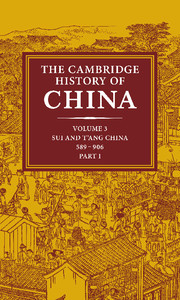Book contents
- Frontmatter
- 1 Introduction
- 2 The Sui dynasty (581–617)
- 3 The founding of the T'ang dynasty: Kao-tsu (reign 618–26)
- 4 T'ai-tsung (reign 626–49) the consolidator
- 5 Kao-tsung (reign 649–83) and the empress Wu: the inheritor and the usurper
- 6 The reigns of the empress Wu, Chung-tsung and Jui-tsung (684–712)
- 7 Hsüan-tsung (reign 712–56)
- 8 Court and province in mid- and late T'ang
- 9 Court politics in late T'ang times
- 10 The end of the T'ang
- Glossary Index
- References
1 - Introduction
Published online by Cambridge University Press: 28 March 2008
- Frontmatter
- 1 Introduction
- 2 The Sui dynasty (581–617)
- 3 The founding of the T'ang dynasty: Kao-tsu (reign 618–26)
- 4 T'ai-tsung (reign 626–49) the consolidator
- 5 Kao-tsung (reign 649–83) and the empress Wu: the inheritor and the usurper
- 6 The reigns of the empress Wu, Chung-tsung and Jui-tsung (684–712)
- 7 Hsüan-tsung (reign 712–56)
- 8 Court and province in mid- and late T'ang
- 9 Court politics in late T'ang times
- 10 The end of the T'ang
- Glossary Index
- References
Summary
This volume is the first of two devoted to the Sui and T'ang dynasties (581–907). It is designed to provide the reader with a narrative account of this complex period, during which China underwent far-reaching changes in political institutions, in her relations with the neighbouring countries, in social organization, in the economy and in every sphere of intellectual, religious and artistic life. The broader issues in institutions, social and economic change and in intellectual developments are dealt with in detail in Volume 4 which also contains a bibliography for both volumes.
A glance at this bibliography will show that a wealth of modern scholarship has been devoted to the T'ang. Chinese scholars have been attracted to the period as one of the high points of Chinese political power and influence, and as one of extraordinary achievements in every field of culture and the arts. Japanese scholars have been drawn to the Sui and T'ang not simply because of the intrinsic interest of the period, but also because it was during these dynasties that Japan was most deeply influenced by Chinese institutions. Consequently Japanese scholars have had a deep and instinctive understanding of Sui and T'ang China which provided so much of the fabric of their own state structure, laws and institutions, art, literature and even of their written language. Western scholars too have long been fascinated by the period – the first full scale political history of the T'ang in a European language was completed by Father Antoine Gaubil SJ in 1753 – and in recent decades have begun to make their own distinctive contribution to the understanding of T'ang China.
- Type
- Chapter
- Information
- The Cambridge History of China , pp. 1 - 47Publisher: Cambridge University PressPrint publication year: 1979
References
- 2
- Cited by



